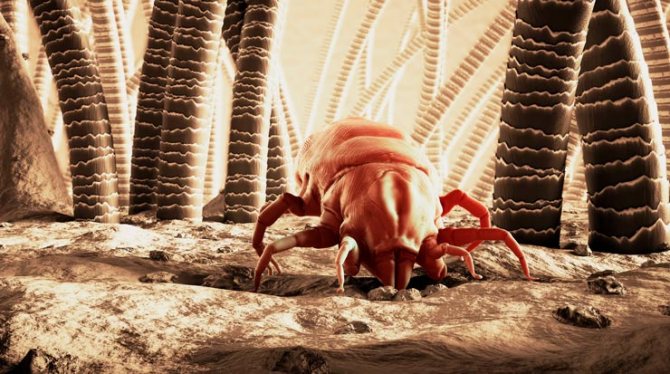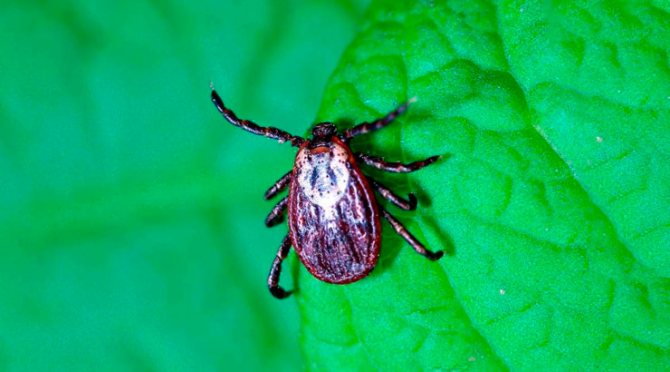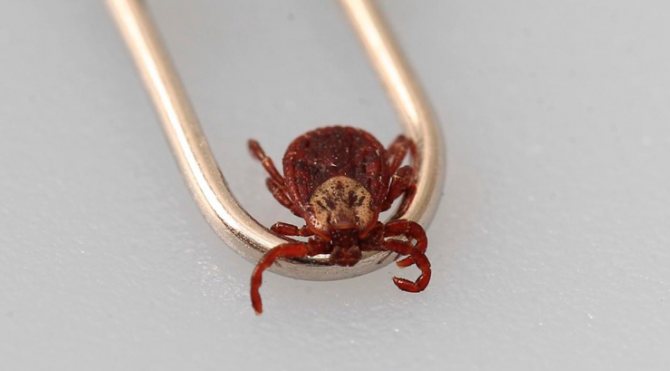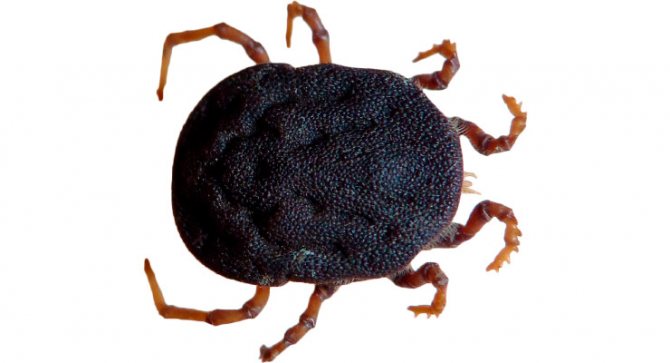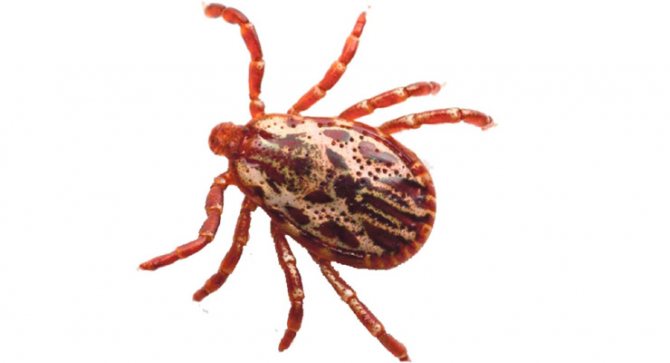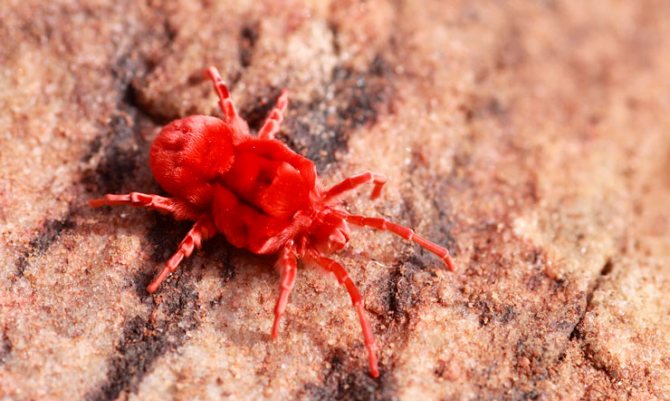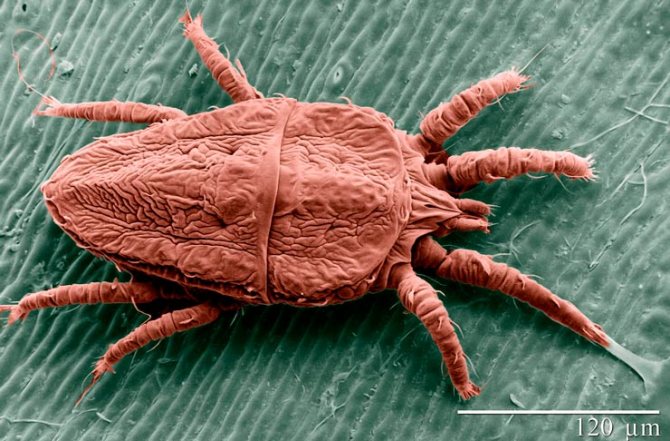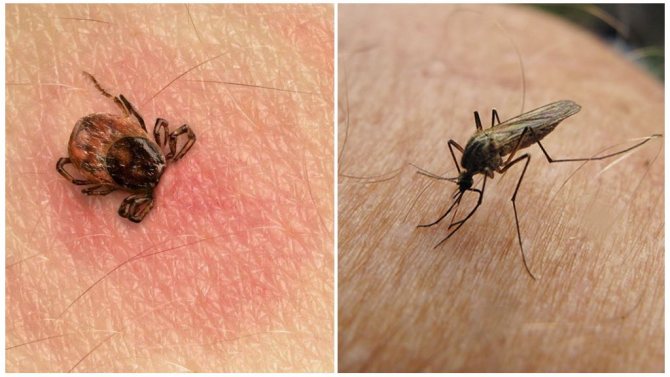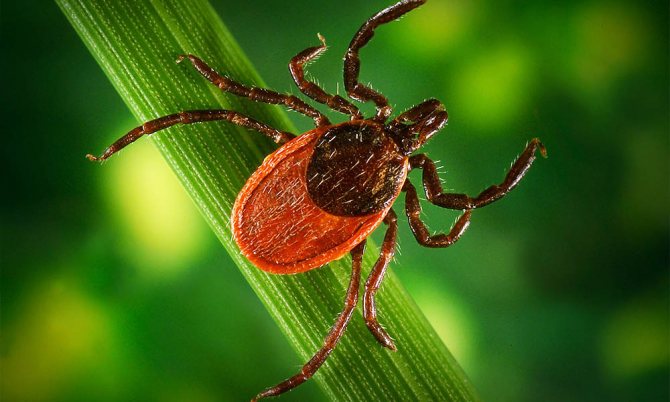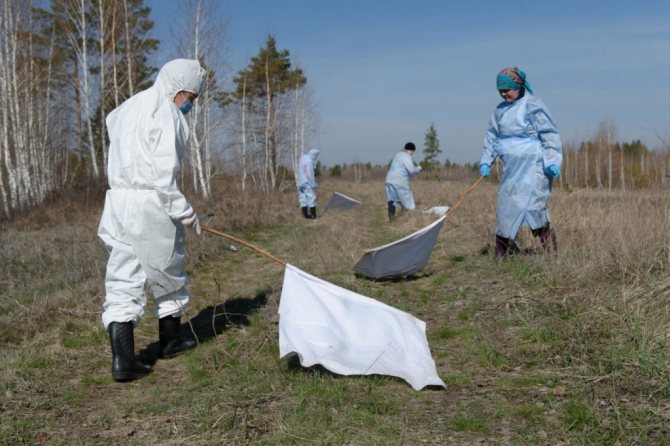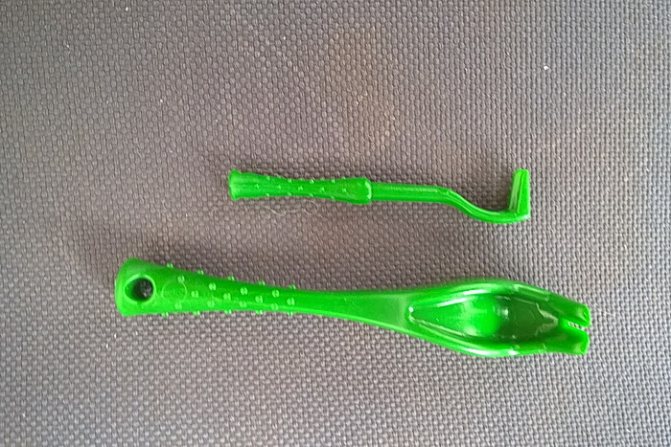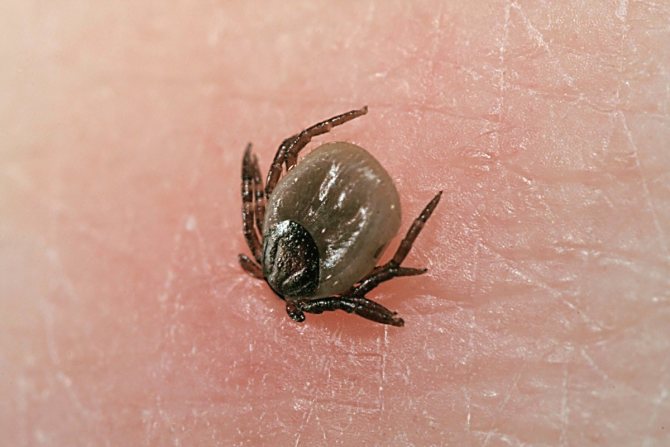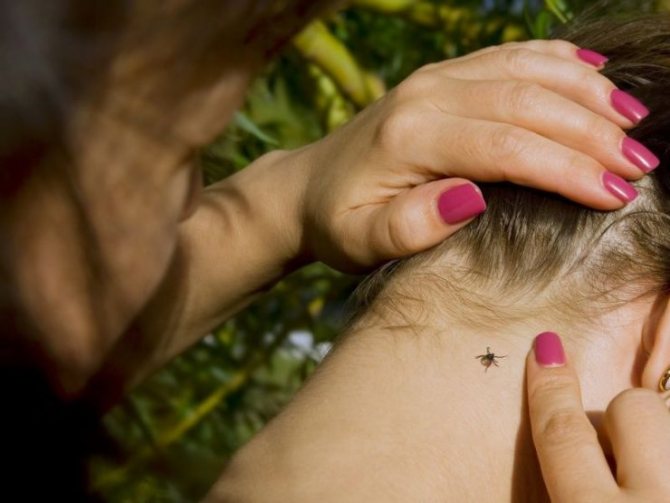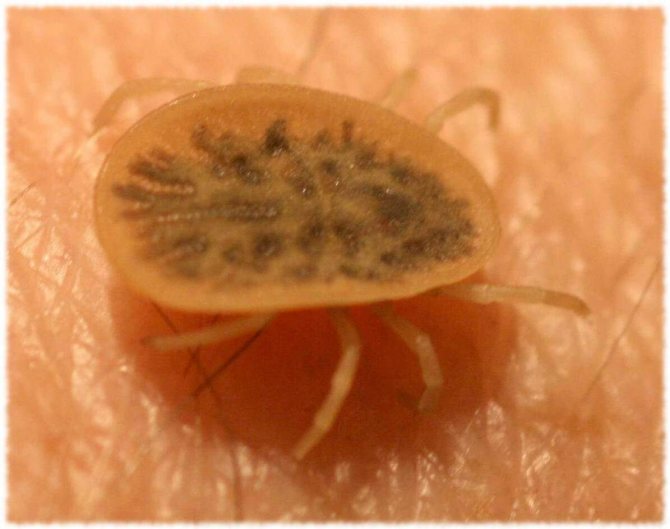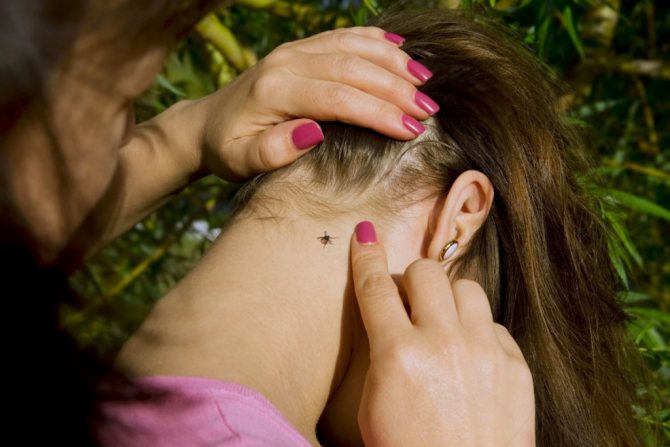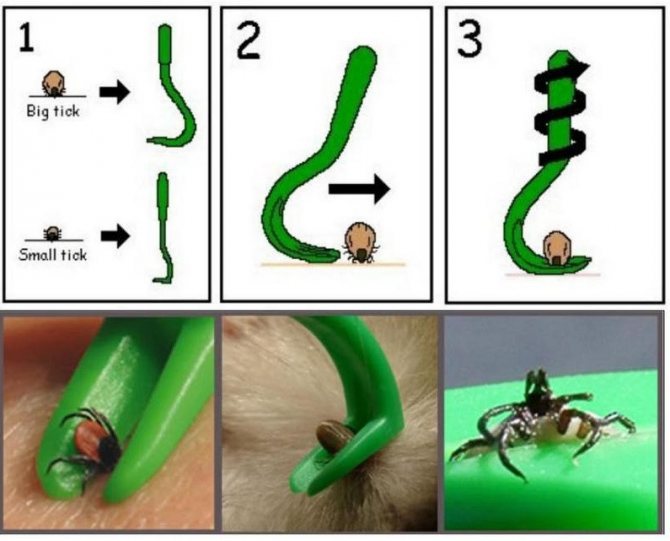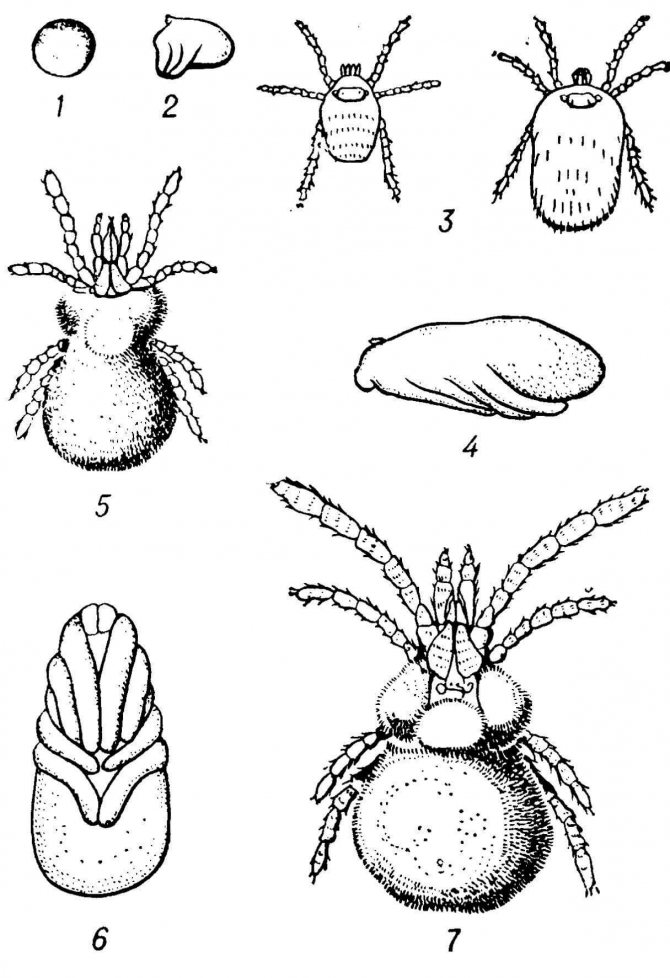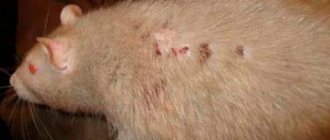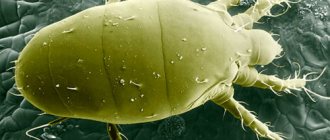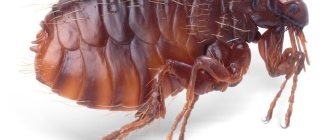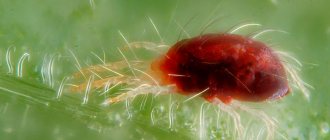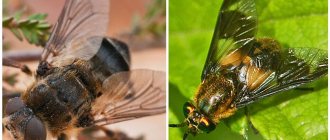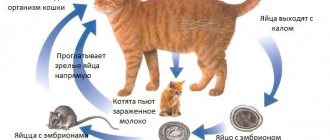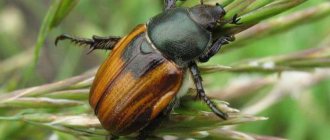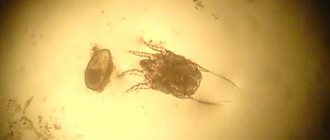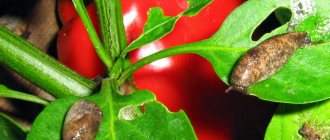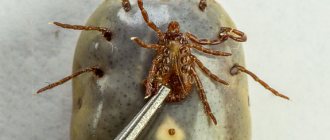Ticks are small arachnids. They perfectly adapt to rapidly changing environmental conditions and reproduce actively. Thanks to this, various types of ticks not only survived for many centuries, but were also able to spread throughout the planet, harming the life and health of humans, as well as pets.
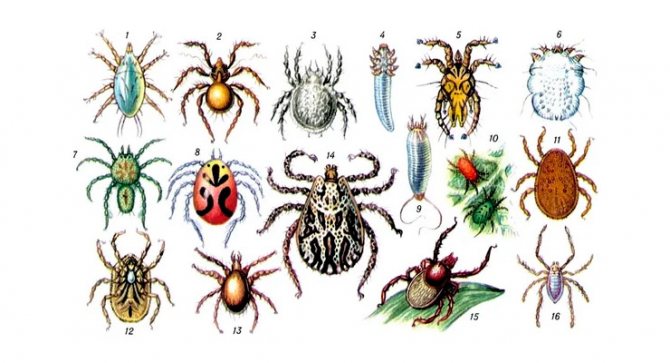
There are many types of ticks in nature, not all of them are dangerous to humans.
General information
These are domestic parasites that easily adapt to new conditions. Under favorable conditions, they multiply rapidly and create huge populations. They live in dust, from which they are also called dusty.
They live in apartments for the reason that there are ideal conditions for them, warmth and sufficient humidity. In addition, they have a constant source of food, and their diet consists of dead skin cells.
They do not bite people and do not belong to bloodsucking, but despite this they pose a great danger. Neighborhood with them can lead to severe allergic reactions, sinusitis, asthma can develop. The waste products of this parasite cause skin diseases in people, and scabies can develop.
Habitats and season of tick activity
It is worth noting that the order Ixodida has more than 900 species and includes 3 families: ixodid (Ixodidae), or actually ixodid ticks, argazid (Argasidae), or argasid ticks and Nuttalliellidae, which include only one species that lives in Africa.
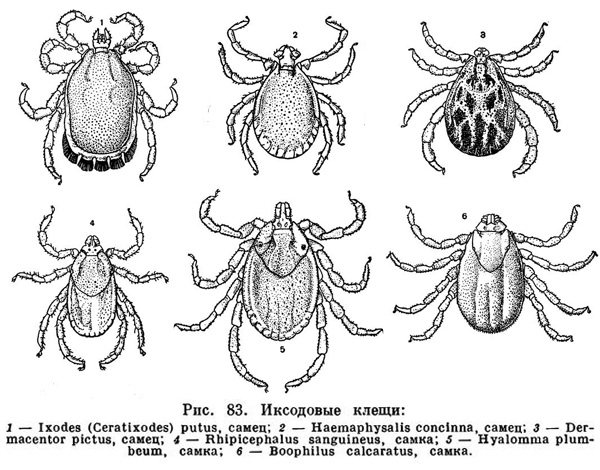

The family of ixodid ticks has more than 600 species.
Argazids prefer countries with dry climates and are found even in deserts, where they have to hide from the sun in various shelters, and at night move for kilometers in search of hosts.
Ixoids, which will be discussed later, prefer not so extreme conditions. Most often, these ticks can be found in warm places with high humidity, it is also important that animals live there, the blood of which can be eaten. These places include animal paths, pastures, forest edges and meadows, vegetable gardens, city parks and squares (the attack of this parasite is possible even on a lawn or flower bed). See also the article Where mites usually live in nature: typical habitats.
On a note
Representatives of ixodid ticks, most often found in Russia, are the taiga tick (Ixodes persulcatus) and the dog tick (Ixodes ricinus). It is these two species that are dangerous carriers of tick-borne encephalitis and borreliosis. Their habitat extends from northeastern latitudes to the European part of the country, that is, they can be found everywhere.
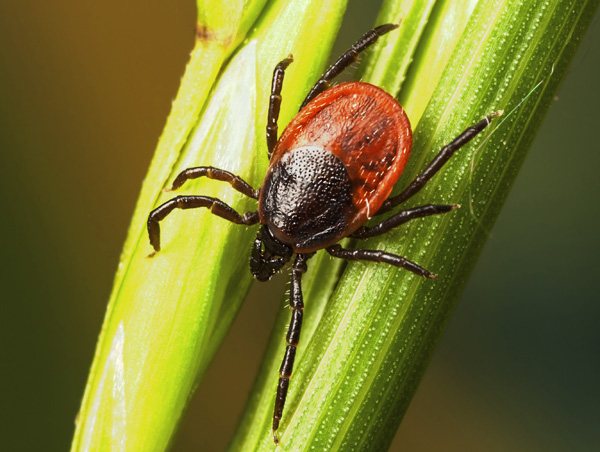

One of the most common species of ixodid ticks, found almost throughout the territory of Russia, is the taiga tick.
In Russia, ticks hunt from early spring to late autumn, but there are periods of particular activity. Spring-early summer and late summer-early fall are known as the times when ticks are most likely to attack humans. In the spring, after the snow melts, adult parasites come out of hibernation and go out in search of prey. They are hungry and very aggressive.
In the middle of summer, especially during dry times, the parasites are forced to hide from the sun in humid places, climbing the grass only at night. Therefore, do not count on the fact that night time will be able to protect you from tick attacks. In this case, in the heat of the day, there is much less chance of picking up the parasite. The daytime activity of bloodsuckers increases again at the end of summer, when it is still warm, but there is no longer heat and lack of moisture, and you can again wait for the victim.
It is interesting
There is an opinion that ticks do not attack in rainy weather. During rains, the activity of ticks really decreases, however, it is worth noting that drizzling rain will not interfere with parasites - sometimes, on the contrary, increased humidity after intense heat will create comfortable conditions for trapping the victim.
Types of domestic parasites
There are several types of ticks that can infect living quarters, they belong to a separate biological group. In addition to the fact that they bring discomfort to their presence, it affects human health and can lead to serious consequences. How they look can be seen in the photo.
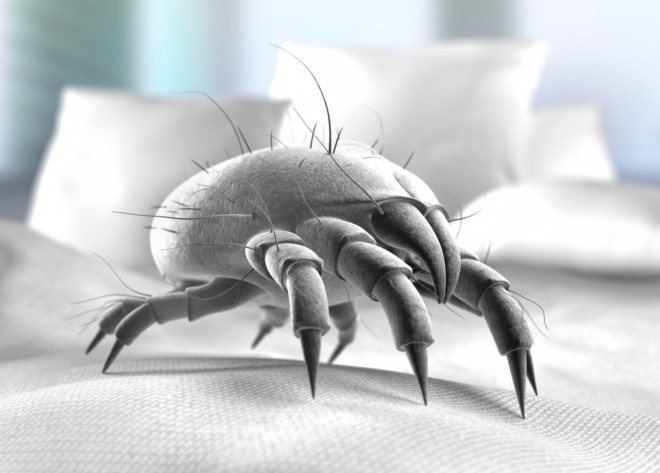

These include:
- Hairy brownie. A parasite found in food, plant and animal waste. They can even appear in tobacco. Their active reproduction depends on external conditions. If the air temperature is 23-25 ° C, and the humidity reaches 80-90%, individuals develop rapidly and after a short period of time a huge colony can live in an apartment. Neighborhood with such furry mites can lead to the development of dermatitis in humans.
- Scabies. This species is also called Zuden. These microscopic mites only parasitize human skin, causing scabies. For them, favorable conditions, warmth and high humidity.
- Rat. As the name implies, they parasitize on rats, but in a hungry state without the usual food source, they attack any mammals, they can also attack people. Lead to the development of rat tick-borne dermatitis, a disease that is very difficult to treat. More common in rural areas.
- Chicken. Their habitual habitat, bird nests or in the crack of wood. They are the most common species and can be found all over the world. When a person is infected, they parasitize on the skin, causing irritation, inflammation and rashes.
- Avian. Their victims are birds, both wild and domestic. But in the absence of the usual victims, people are attacked.
- Household. As you can understand, this species belongs to domestic inhabitants, the danger lies not only in bites, but also in the fact that their feces cause various diseases in humans.
- Bed, dusty. Microscopic individuals that simply cannot be seen in the apartment. To see such a parasite, you will need to use a microscope.
Methods of protection and prevention
Methods of protection and adherence to preventive measures will help protect against a tick bite. Going on a picnic or hiking, you should:
- Find out what a blood-sucking parasite looks like in order to get rid of it in time.
- Wear tight-fitting clothing and a hat. At the same time, the clothes should be plain, light in color, this will allow you to quickly detect the parasite.
- Bypass tall grass, damp places, do not wander near bushes.
- Examine yourself every hour for ticks.
- Clothes and open areas of the body are treated with special aerosols and tick repellents.
- Pets often carry parasites in their coats, so they should be carefully examined after each walk.
- Upon returning home from the forest, it is recommended to take a bath.
Vaccination can reduce the risk of contracting tick-borne encephalitis to a minimum.This is the most basic prophylactic against ticks, which, if infected, will ease the course of the disease. The only condition for the body to have time to develop immunity is that vaccinations are done according to the scheme, 2-3 months before the start of the tick activity season.
Bed mite
In order to have at least an approximate understanding of how small these parasites are, an example can be given, in 1 gram of dust there can be up to 1 thousand individuals. The increase in the number of individuals is affected by the heating season, then the population can increase significantly. In total, there are 150 species of mites that inhabit the dust.
They are arachnids, have a flattened body shape. The body itself consists of several segments connected to each other. They have 4 pairs of limbs, each foot has special suction cups that make it possible to firmly hold on to any surfaces.
They have strong jaws with which they grind and absorb food. The body is covered with a layer that repels moisture and water.
Does the tick hunt or does it accidentally hit its prey?
The choice of a victim depends on the stage of development of the tick. The larvae live on the ground, in deciduous litter, crawl into animal burrows and feed mainly on the blood of rodents and birds.
Older nymphs can climb the grass and attach to larger warm-blooded animals such as hares, badgers, foxes, squirrels, cats, dogs, but they can also get on people. A pet after a walk may well bring on itself such a "passenger", who, not having time to suck on the animal, will safely move onto a person.
More dangerous is the stage of the adult - an adult arthropod. It is more aggressive, can travel farther distances, climb grass and bushes higher than its younger relatives, and the more hosts a parasite has, the more likely it is to carry a dangerous infection.
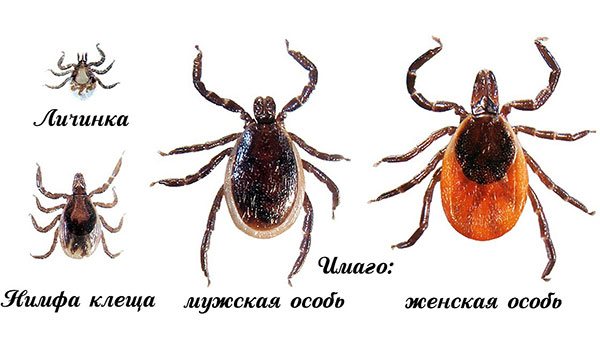

Stages of tick development.
Searching for a prey by a tick consists of two stages. The first is orientation in space. The tick studies the environment: temperature, humidity, air composition, and climbs the grass to the most comfortable place.
Depending on the type and stage of development, parasites trap their victims in grass and bushes at a height of several centimeters to a meter. Ticks are located in the selected place and await the victim, extending the front pair of legs, where the claws are located, with the help of which they attach and hold on to the host's body.
It should be noted that there is no question of the "attack" of ticks on a person or an animal, since they are not physically fit to jump, or run fast, or, moreover, fly. All that a tick can do is choose a good hunting spot and lie in wait (passively or actively) for its prey in order to cling to it in time when it comes to a sufficient distance.
It is interesting
Ticks do not wait for their victims on tree branches. They do not climb that high, so do not be afraid that the parasite may jump or fall from the tree.
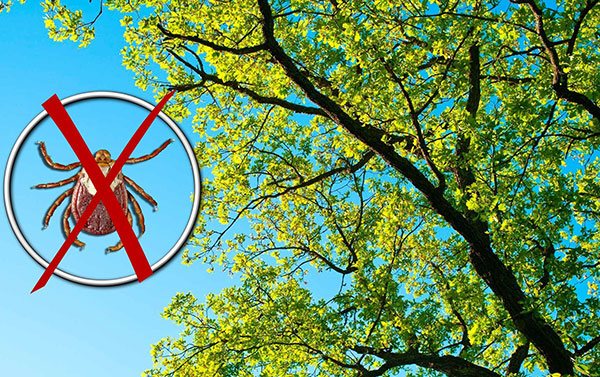

Ticks do not climb tree branches, but wait for their prey in the grass or on low bushes.
When the tick finds its prey, the second stage begins - from passive it goes into active trapping. He turns in the direction from which the stimuli are coming and perceives them, making oscillatory movements with the front pair of legs until contact with the owner occurs.
In addition to passive and active trapping, some types of ticks can pursue their prey. The border between these types of behavior is conditional, since those species that are inherently trapped can go hunting. This happens if the host has not appeared in the immediate vicinity, but continues to be captured by receptors.Then the tick can go down or fall to the ground, crawl and cover the distance of 5-10 meters to the selected animal or person.
It is interesting
During passive waiting, the mite loses moisture. To restore water balance, he has to descend from the grass to places with high humidity, for example, in leafy litter or cracked soil. There the mite absorbs water over the entire surface of the body.
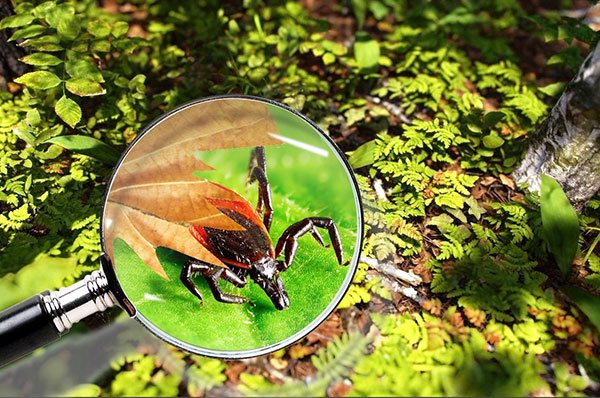

Without waiting for a victim, the mite descends into the leaf litter to restore moisture loss.
Having found a victim, the tick catches on to it. Hooks, spines and bristles located on the legs help the parasite to stay on clothes, they also help the tick to move around the host and stay in place when trying to shake it off.
It is also useful to read: Dog tick (Ixodes ricinus)
Where are the small parasites?
Often they choose places to live where a person does not carry out frequent cleaning and dust accumulates there. Also, by the name, you can understand that bed mites do not bypass people's beds and sofas.
In fact, there are a huge number of places where they can settle, for example, they prefer pillows that are filled with down and feathers of birds. The ideal habitat is mattresses, they do not take a long time to clean, and they can multiply in them without hindrance.
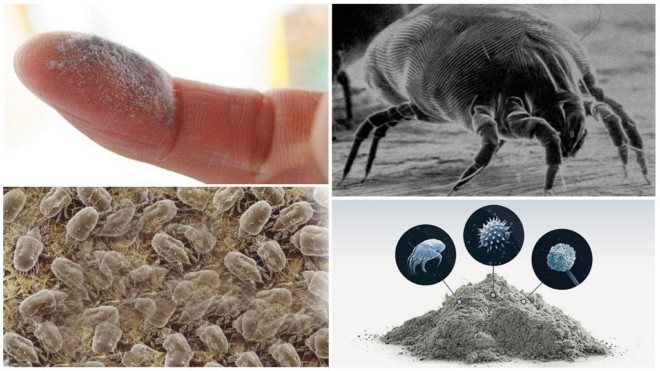

Also, they will not bypass wadded blankets, carpets, bedding, fleecy coatings, children's toys, upholstered furniture, woolen blankets. They can be found on bookshelves where dust is not removed, curtains that do not wash for a long time, as well as in old things that have been folded for a long time and cannot be cleaned.
That is why these pincers have many names, clothing, furniture, mattress, clothes, clothing.
If we talk about statistical data, then the largest number of them is found in a person's bed. There can be up to 2 million such bed parasites in one bed. All of them secrete waste products that are dangerous to humans.
Such products get into the air, then settle on human surfaces and skin, enter the respiratory tract, which causes allergic reactions.
Rules of conduct in nature
To avoid a tick bite and dangerous consequences, you must adhere to the following simple rules of behavior in the field:
- Use plain light-colored clothing - it will be easier to notice the parasite that has stuck on it;
- Restrict access to the body as much as possible. You should choose clothes with a tight-fitting collar and cuffs, tuck the jacket into the pants, and the pants into the socks, use a hat. Special anti-mite suits can be used;


To avoid tick bites, you should wear clothing that covers all parts of your body, and do not forget about a headdress.
- Try to avoid places that are likely to have ticks. These include glades with tall grass, animal paths, pastures;
- Every 10-15 minutes, clothes should be inspected, and at halts, the whole body should be carefully checked;
- Use tick protection. Today there are a large number of drugs that, depending on the type of exposure, are divided into repellent, acaricidal and combined. Repellents scare away ticks, acaricides kill, and combined ones act in two directions at once.
Compliance with the above methods of protection will help protect yourself from negative consequences in a personal meeting with a forest parasite.
The mechanism of the attack of ticks and the structural features of their oral apparatus
Do bed parasites bite?
These microscopic arachnids do not have a special piercing-sucking apparatus to which a bite could be inflicted. In addition, they are so small that they simply could not bite through the skin of a person. They do not bite, do not drink blood, and do not tolerate dangerous infectious diseases. But despite this, he is able to bring no less problems.
People who are prone to allergic reactions should be as careful as possible, because in addition to unpleasant symptoms, serious complications can develop. If any symptoms are found, you should immediately contact an allergist or immunologist, who will make the correct diagnosis and prescribe an effective treatment.
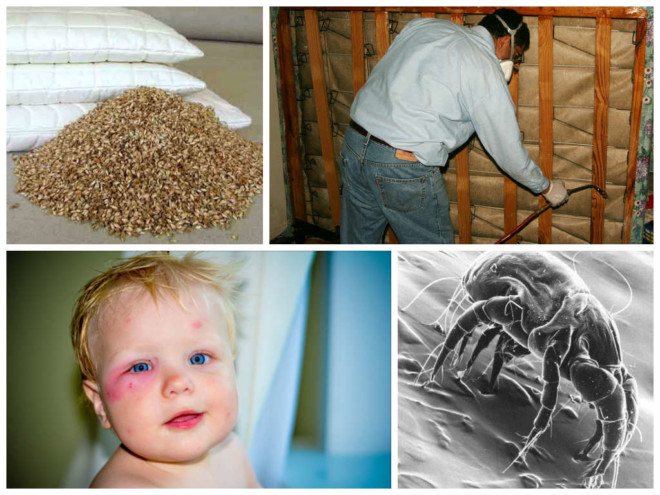

Very often, bed mites are referred to as those that cause bites. This happens for the reason that they are confused with bed bugs, which really bite. Such inhabitants leave numerous bites on the human body, they are very close to each other, such an affected area turns red and swells.
Why is a tick bite dangerous?
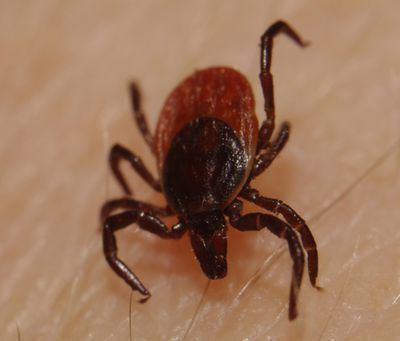

Why is a tick dangerous for humans? In addition to the fact that the insect sucks blood from a person, it injects its saliva into the victim's body, which contains an infection. That is why ticks are the source of a number of serious and dangerous diseases.
Many of them are difficult to treat and cause great harm to the entire body. In addition to blood-sucking ticks, there are other species that, with their bites, can cause allergies, as well as severe itching. Why are ticks dangerous? We will discuss this now.
Diseases arising from a tick bite
Why is a tick bite dangerous for humans? Consider the diseases transmitted by these insects and their symptoms.
Lyme disease characteristic:
- constant state of fatigue;
- headache appears;
- the site of the bite turns into a noticeable wound;
- there is a red rash over the body;
- with timely treatment, it is easily stopped by antibiotics.
Spotted fever, characteristic:
- body temperature rises significantly;
- there is severe pain in the head;
- nausea is observed, vomiting is also possible;
- there is soreness in the muscles;
- a rash appears on different areas of the skin, most often on the wrists, arms and legs;
- causes serious complications, in the future, stroke or impaired renal function is possible.
Tularemia, characteristic:
- chills of the body;
- a very high temperature rises;
- headache worries;
- nausea;
- lymph nodes are enlarged;
- there is swelling in the area of the bite;
- an open wound is formed;
- serious consequences are possible, such as pneumonia, peritonitis, gangrene, etc.
Ehrlichiosis, characteristic:
- manifests itself from the first day after the bite;
- persistent nausea and vomiting;
- weakness is felt;
- Strong headache;
- inflammation occurs in any organ;
- there may be a state of chills;
- the outcome of this disease is unpredictable, since the disease can pass asymptomatically, or it can cause serious damage, up to and including death.
Relapsing fever, characteristic:
- the heartbeat increases significantly;
- unbearable pain in the abdomen and head is felt;
- weakness of the whole organism is observed;
- feverish condition;
- usually heals without consequences, no death is observed.
Encephalitis, characteristic:
- the temperature is kept around 39;
- there is a fever;
- severe chills;
- weakness of the whole body, muscle soreness;
- there is a pronounced detachment in consciousness;
- severe consequences in the form of meningeal syndrome and paralysis;
- manifests itself three days after the bite.
Babesiosis, characteristic:
- constant feeling of unwell;
- complete aversion to food;
- general fatigue is felt;
- worried about fever and chills;
- anemia develops;
- the disease provokes renal and hepatic failure;
- profuse sweating.
I would like to note that even if a preliminary vaccination against a tick bite was carried out, it only helps against encephalitis and does not apply to other diseases.
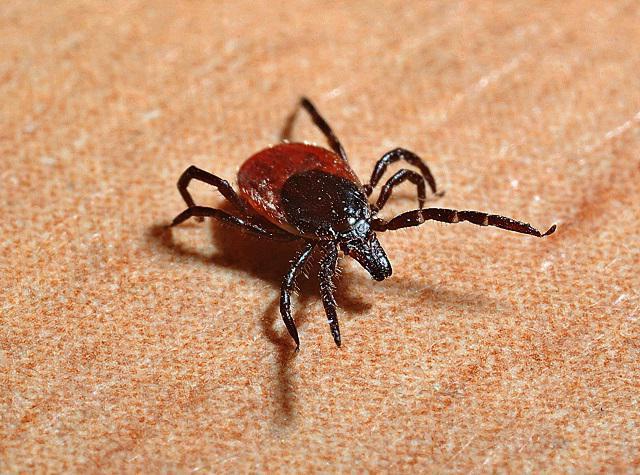

Tick activity periods
Seasonality is directly related to the activity of ticks and the danger from their bites.
Features of the behavior of ticks in the spring:
- the end of April is considered the beginning of an attack by ticks on humans and animals;
- in May, the number of individuals increases significantly;
- spring is considered the most dangerous period, since during the winter they become very hungry and accumulate a lot of toxic substances;
- the probability of contracting encephalitis when bitten by an infected tick is about ninety percent.
Features of the behavior of ticks in summer:
- at the beginning of June, females actively stick to mammals in order to start reproducing offspring after they are full;
- by the end of summer, the harm from a tick bite decreases, since they are no longer so hungry and the concentration of poison in saliva decreases.
Features of the behavior of ticks in the fall:
- in September, activity drops significantly;
- in warm autumn, a tick bite can be obtained in October.
If the summer is very hot, then the activity of ticks decreases markedly, since they cannot tolerate heat above thirty degrees. These insects hibernate at plus four.
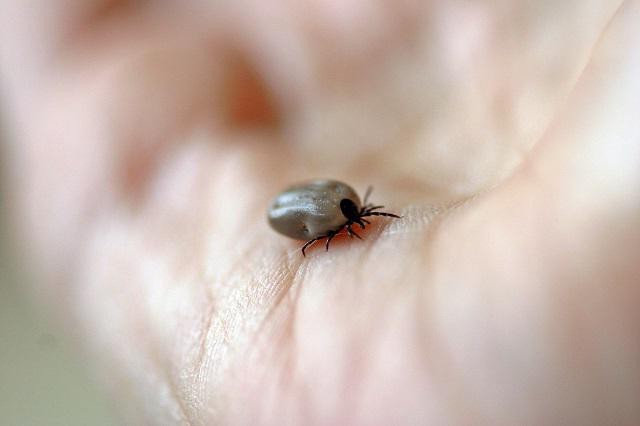

What ticks are considered dangerous to humans
What ticks are dangerous to humans? There are several types of these insects that are harmful. Some of them interfere with agriculture, settling on cultivated plants.
But there are those that parasitize on the human body, causing terrible, intractable diseases. Usually these are small individuals, less than half a centimeter in size, but there are also large specimens, up to two centimeters.
Types of dangerous ticks
Among the ticks that harm human activities, the following types are distinguished.
Barn pliers, characteristic:
- settle in flour and cereals;
- getting on a person, cause allergies;
- do not stay on the body for long, as they mostly prefer plants;
Bed mites, characteristic:
- found in bedding, carpets and mattresses;
- feed on dead human cells and scales;
- can provoke allergies in the form of rash and itching, in rare cases cause bronchial asthma.
Dust mites characteristic:
- live in an apartment on furniture among the dust;
- a person is allergic to them;
Scabies mites, characteristic:
- very small in size, almost impossible to find on the human body;
- transmitted through touch or common household items;
- conducts its activity directly under the skin, gnawing tunnels in it and thereby causing severe itching.
Which tick is the most dangerous for humans
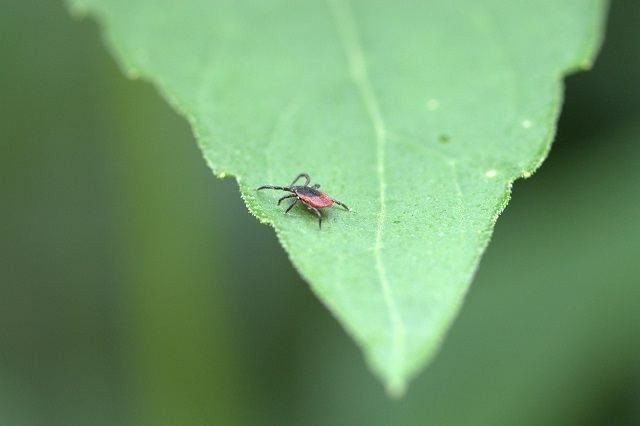

Ixodid ticks are considered the most dangerous to human health. It is they who, by attaching and sucking blood, carry many infections. Biting into the skin, the parasites stay for several days or even a week, transmitting the pathogens of the virus with saliva. This is why it is important to know what they look like.
Ixodid ticks, description:
- oval shape, the body itself is flat;
- the color range varies from light shades of brown to black;
- covered with strong and elastic chitin, which cannot be crushed, but at the same time, as it fills with blood, stretches well;
- tick eggs are oval, no more than a millimeter;
- the stages of development are the stages of larva, nymph and imago.
Among all diseases transmitted by ixodid ticks, encephalitis is considered the most dangerous. It can be mild or severe. In the first case, a person has a feverish state, which completely disappears after a couple of weeks. In the second, the brain is affected, which leads to paralysis, mental disorders or even death.
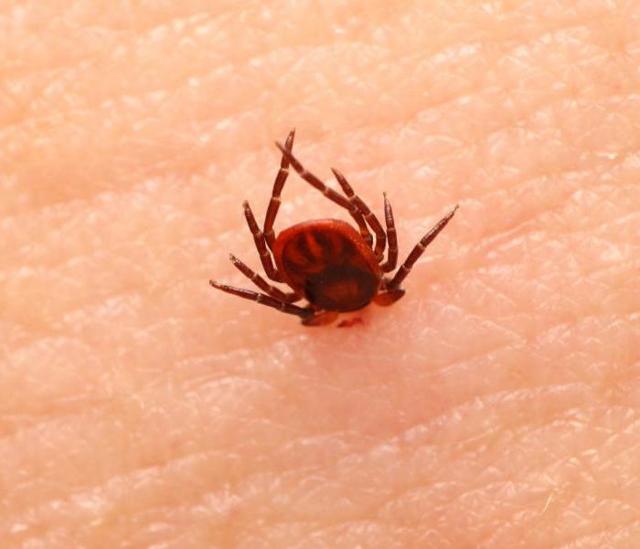

Mite habitats
To avoid tick bites, you need to know where they live. Ticks prefer to settle and attack their prey in the following places:
- in areas with dense and damp vegetation;
- in shaded areas full of foliage;
- in the undergrowth;
- in the meadows;
- at the bottom of ravines full of moisture;
- in thickets near water bodies;
- in the grass on the well-trodden paths.
Causes of infection and where they come from
The fact is, no matter how strange it may sound, these small parasites are present in absolutely every home.When the owners monitor the cleanliness of the room, carry out frequent washing of bed linen, bedspreads, get rid of dust, vacuum and wash the room, then the population is kept within normal quantitative limits, such permissible colonies are not capable of harming humans.
But when favorable conditions for their development and reproduction appear in the apartment, their number increases significantly. Such favorable conditions are created in the absence of wet cleaning, regular change of linen.
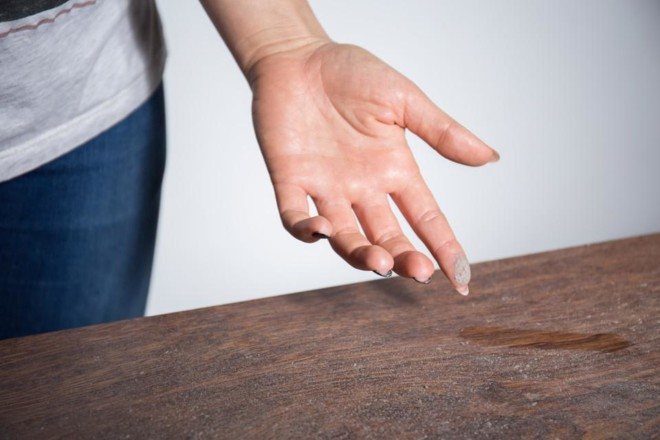

There is an accumulation of pili, and therefore a favorable environment for them, where they lay eggs, and the amount of food also increases, since there is an accumulation of keratinized skin particles that are necessary for nutrition.
Methods of attack
The tick attacks in a jump. His lightweight body is well carried by the wind, so it is not difficult for him to jump on you and look for a place to drink blood. As soon as they hit the skin, the parasite climbs to those places where it is easier and easier to bite. Usually these are the chest, neck, armpits, knee and groin sockets.
We suggest that you familiarize yourself with: How to get rid of scolopendra in a private house
Also, a tick may not jump, but fall on you from a tree, catch on clothes in tall grass, jump off animals. Then everything happens according to the scheme described above.
The parasite bites into the neck, chest, armpits and groin
How to fight them
Unfortunately, there is simply no way to guarantee complete elimination of these parasites. There are a large number of ways that can significantly reduce their number, thereby reaching a population level that will not harm humans.
There are chemicals that help get rid of huge populations of linen mites, the most popular are:
- Allergoff. It is produced in the form of a spray, the action of which is directed not only to the pests themselves, but also to allergens that are contained in waste products.
- Easy Air. Presented in the form of a spray, suitable for application to any surface. As in the previous version, it has a complex effect.
- Milbiol. This aerosol acts directly on linen parasites, mattresses, pillows and any other textile products are treated with it. The active substances of the drug stop growth, disrupt the processes of development and nutrition.
- Dani Earth. Also, as in the previous version, it is applied to textile surfaces, it helps to quickly remove mattress mites.
- Tsifox. Treat potent toxic drugs. It is effective, but at the same time, if used improperly, is dangerous to the health of people and animals. Its use should be carried out strictly according to the instructions and in compliance with all safety measures.
- All — Rug. The tool is presented in the form of a shampoo, which is used for wet cleaning.
The most serious diseases
The most serious diseases that can be transmitted from ticks to humans are:
- Monocytic ehrlichiosis. The first symptoms of the disease are fever, severe fatigue and joint pain. After that, malfunctions occur in the central nervous system, the condition of the blood vessels worsens and the work of the musculoskeletal system is disrupted.
- Encephalitis. Usually the incubation period lasts from 7 to 20 days, the first signs of this dangerous disease can be easily confused with ARVI - these are fever, joint pain and migraine. A few days later, the temperature rises sharply to 39-40 °, vomiting and photophobia are added. The patient feels lethargic and depressed, a plaque appears on the tongue.
Important! If you do not start treatment of tick-borne encephalitis on time, the consequence can be brain damage, impaired memory and speech apparatus, mental disorders.Often the disease leads to epilepsy and disability, in some cases - to death.


The consequence of encephalitis can be brain damage
- Tick-borne borreliosis. On the skin area where the bite occurred, a papule appears in the form of a ring with a diameter of 10 to 60 cm. The formation begins to itch, swell and ache. Also, the disease is accompanied by a sore throat, cough and rhinitis.
- Hemorrhagic fever. Most often, the primary source of the disease is animals - after being saturated with their blood, the tick infects itself, and then the fever reaches humans along a logical chain. The infection affects the walls of the blood vessels, disrupting their integrity. As some vessels become clogged, excess blood builds up in others. The disease is often fatal.
Read also:
How to take antibiotics for tick bites
Other means
You can prepare the remedy yourself, which will also help in the fight and show good results. To do this, take 1 liter of water and dissolve 200 g of salt in it. This solution can be used to treat beds, carpets, the space under sofas, any textile items and places where dust accumulates.
If people with allergic reactions live in the apartment, you can purchase a vacuum cleaner with an aquafilter, which retains allergens, namely, does not allow parasite excrement to spread throughout the apartment. A household steamer is quite effective.


It produces hot steam, which is harmful to mites. It will help with the processing of pillows and mattresses. Of course, you should regularly carry out wet cleaning, wash bed linen, bedspreads, clean carpets and furniture, get rid of dust.
High and low temperatures have a very good effect. For example, in winter you can take out pillows, blankets, mattresses, carpets and other things for airing. If this is the summer period, then direct sun will provide a similar effect.
But it should be remembered that with large populations it is necessary to use insecticides, and when the number decreases, use these preventive actions.
Bite detection
Since it is impossible to feel the bite of the parasite, a thorough examination must be carried out. To do this, you need to know which parts of the body he prefers to choose for nutrition. The tick hits its prey, then crawls over it for a long time in search of thin skin. The most delicate places are easier to bite through, so he most often bites:
- in the back, stomach;
- neck;
- armpits;
- groin;
- clavicle area;
- behind the ears.
Children need to be examined more carefully, as they have delicate, thin skin and the parasite can suck anywhere.
Important! If you find a tick, do not panic and try to pull it out, you should immediately contact the nearest emergency room.
Removing the parasite
The place where the tick has sucked becomes inflamed. It starts to ache slightly only after 1-2 days. Sometimes suppuration appears, the wound does not heal, it itches a lot. You can remove the parasite yourself or seek help from a medical facility. For self-removal, apply:
- Thread... Use a thread to get rid of large or medium-sized ticks. A loop is made of strong thread, which is wrapped around the head of the parasite. It is slowly pulled out of the skin, after tightening the loop.
- Tweezers... The wound is lubricated with hydrogen peroxide or alcohol. Tweezers grab the tick's head, then gently twist it out of the skin.
- Twisted with your fingers... In order not to infect the hands, before removing the parasite, they are thoroughly washed and treated with an antiseptic. The arthropod is grasped with two fingers: thumb and forefinger, then gently twisted counterclockwise. You cannot squeeze the tick strongly, otherwise it will burst, after which suppuration and inflammation of the wound will occur.
- Insulin syringe... The lower part of the syringe, where the tube is located, is cut off.Cover the tick with a prepared syringe. A vacuum is formed inside the medical instrument, lifting the piston, the parasite will jump out of the skin. If the affected area is moistened with water or lubricated with oil, the effect will be better.
- Needle... The sewing needle is burned over a fire until it darkens. When it cools down, it is inserted under the head of the arthropod, then slowly raising it, the proboscis is pulled. The previously damaged area is treated with an antiseptic.
- Butter... The parasite that sits deep in the skin can be removed with any coating agent (vegetable oil, petroleum jelly). One drop of the substance will block the access of oxygen to the tick, and it will crawl out. You shouldn't use this method. There is a possibility that the insect, before crawling out, will vomit back into the wound everything that it has eaten. Then the risk of contracting an infection will increase several times.
- Extractor... You can use the tick extraction tool. With their help, the parasite is removed along with the head.
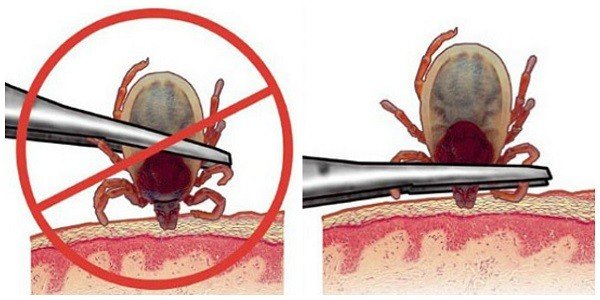

How to remove a tick
The wound remaining after the removal of the insect is washed with soap and treated with iodine. For several days, you need to carefully monitor your health. To find out whether the parasite is infected with tick-borne infections or not, it is taken for research.
Note! You can even catch an infection from a tick by providing first aid. This happens if you do not wash your hands after the parasite and touch the mucous membrane of the nose, mouth or the membrane of the eyes.
Preparation for analysis
The presence of infection is determined using PCR diagnostics. To do this, it is enough to bring individual parts of the insect to the laboratory. For microscopic diagnostics, the tick must be alive. The rules for saving it:
- the insect is placed in a small glass bottle;
- a piece of cotton wool is moistened in water, then also placed in a bottle;
- the container is tightly closed with a lid and stored in the refrigerator;
- instead of a bottle, the insect can be wrapped in gauze or placed in a cardboard box.
The disease can be diagnosed not only by examining the tick, but also by analyzing the blood. A blood test for borreliosis and encephalitis is carried out by PCR 10 days after the bite. If you hold it right away, it will show nothing. For antibodies to the encephalitis virus - after 14 days, to Borrelia - after 21 days. If an infection is detected, the patient will be injected with a drug that stops the development of the disease. Where you can take a tick for analysis in your region, you can find out here.
Traditional methods
The undoubted advantage of traditional methods is availability, low cost and complete safety for people and animals. A simple yet highly effective solution can be prepared.
To do this, you need to take 1 liter of water, add 100 g of ammonia and 50 g of soap. You can use liquid or solid soap, but you must first grind it on a grater.
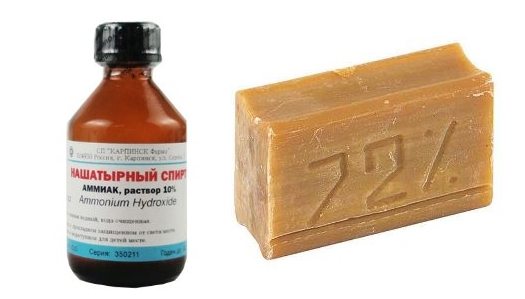

All components are thoroughly mixed and the solution is ready for processing, it can be applied to linen, sofas, beds, mattresses and other things. You can also use herbs such as marsh rosemary, tansy, wormwood. These plants can be spread out around the room, or you can prepare a decoction for use in wet cleaning.
Danger to humans
As already mentioned, these pests are not able to bite, but the danger is that their excrement gets on human skin, mucous membranes and enters the respiratory tract, which provokes the development of allergic reactions.
A person may develop rhinoconjunctivitis, rhinitis, dermatitis, respiratory allergies, bronchial asthma, Quincke's edema. The fact that a person develops an allergy, symptoms such as coughing, sneezing, redness of the mucous membranes of the eyes, wheezing, lacrimation are burning.
Treatment is prescribed only after diagnosis, which involves the delivery of tests and microbiological studies.
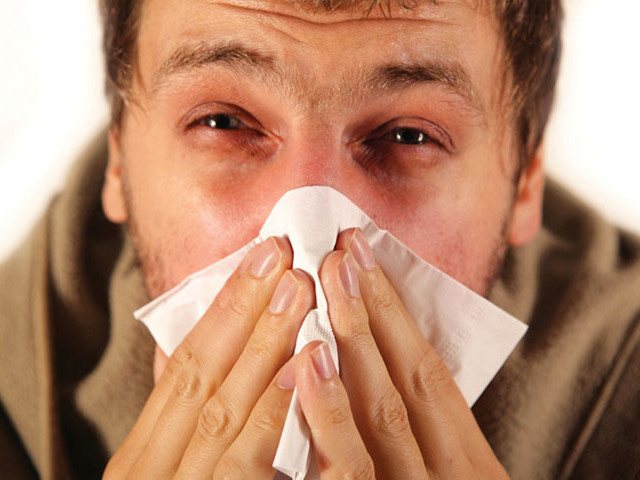

To cure diseases caused by bed mites, complex actions are required. It is imperative to eliminate the allergen, the doctor prescribes medication and desensitization is used.
This helps the body to resist the allergen. In some cases, a minimum dose of the allergen extract is administered to a person, and then the dosage is increased. Desensitization helps the body develop a defense mechanism against the allergen.
Preventive actions
Remember that regular, regular cleaning of the premises is an excellent preventive measure that will minimize the chances of breeding and population development to dangerous numbers. Change your bedding regularly.
Remember to clean your pillows and mattresses, which are ideal breeding grounds for colonies. The ideal habitat is dust, which means that you need to get rid of it regularly, remove hard-to-reach places.
Ventilate the room during the winter. Pay attention to carpets, take them to a dry cleaner or take them out to air. Baby toys should be washed as the pile is ideal for creating insect colonies in it.
Removing a tick from the body
If a tick has bitten you, then serious and urgent measures must be taken. However, the parasite cannot be simply ripped out or crushed. In both cases, his head will remain in the body. The first thing you should do is see your doctor as soon as possible. We have already described how to remove a tick on our own, we will briefly recall this again.
If it is not possible to visit a doctor, then you need to prepare to fight the tick on your own. Check to see if there is oil or soap at home. If so, you're in luck. If not, you will spend time looking for this ingredient, and in the case of ticks, every second counts.
Once you find the oil, lubricate the area around the parasite, take a tight thread and make a loop. Put it on the tick and slowly begin to twist it clockwise, being careful not to crush it. However, you will not be able to find out whether an infected tick attacked you or not. It will be easier to put it in a bag and take it to the hospital for examination.
And what to do if your pet is bitten by a parasite, described in this article.
The pulled out tick must be sent for analysis.

